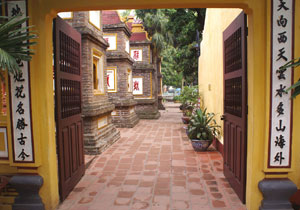THE ROVING DIPLOMAT
TRIBUTE SERIES
JANUARY 2001
STRATEGIC ASIAN LANDSCAPE
From Sonia Gandhi in India to US President Bill Clinton’s visit to Hanoi
A South Asian event that attracted global attention was the reelection of Sonia Gandhi as the President of the Congress Party in India. It was a resounding victory that was celebrated with much jubilation. The impact of the victory on her personal fortunes and those of her party isn’t clear, and whether it can restore the standing of the Congress Party as well as her own image remains to be seen.
A new state has been inaugurated in India – the last of three which were created recently. Established in November 2000, Jharkhand was carved out of Bihar.
Bihar is one of the most populous and wealthiest in the country, because it holds a third of India’s coal, iron ore and copper. Ironically, the creation of Jharkhand was followed by a tribal uprising, which has disrupted the new state.
The international image of India was further enhanced in a statement by the President of Singapore S. R. Nathan when he welcomed India’s President K. R. Narayanan during his visit to Singapore. Nathan’s welcome address noted that India will be an important player in the new equation emerging in the Asian strategic landscape in the post-Cold War era.
For his part, Narayanan stated that it was the endeavour of India to combat fundamentalist designs to subvert the unity and stability of nations. Both sides pledged to promote cooperation because as Narayanan stated, India’s destiny was intertwined with that of Southeast Asia.
Further evidence of India’s growing power and prestige was the statement by its defence minister in parliament. He remarked that India could now design and develop ICBMs with a range of over 5,000 kilometres. The only other countries that possess this capability are the five recognised nuclear powers.
Another notable event that occurred recently was the three-day event in the form of a visit by US President Bill Clinton to Vietnam.
The US president is the first American leader to visit Hanoi since the debacle of 1975 when US forces were expelled from Vietnam. The object of the visit is no doubt to proclaim formally the end of a period of bitterness, which followed the war, and hopefully inaugurate an era of cooperation between the two countries.
Clinton received a wonderful public welcome in Hanoi in sharp contrast to the formal meeting with Vietnam’s leaders. This suggests a possible divergence in outlook between the regime and its public, which accorded a hero’s welcome to the US president.
With characteristic aplomb, Clinton waxed eloquent in his keynote speech at the Vietnam National University in Hanoi about the future of friendly relations.
But any hope that the US president may have entertained about having an impact on the ideology of the regime was dismissed by Communist Party Secretary General Lê Kh Phiêu. In his statement, he demanded that the US should respect Vietnam’s monolithic political system and its commitment to a socialist economy.
Though the visit was not an ideological success, it has to be seen in the wider perspective of Clinton’s statesmanship in recent times.
The visit may have marked a tilt towards Asia as US Secretary of State Karl Inderfurth has described it. But it was more the vision of universality on the part of the United States to break away from existing inhibitions and venture forth into the world at large – especially those parts that it had neglected such as Asia.
Indeed, the visit to Vietnam should be viewed as the sequel to his tour de force in India and then on to the two Koreas. The latter was a spectacular achievement in that it brought about the union of the two Koreas after many moons.
Vietnam was part of this saga of presidential statesmanship and though devoid of spectacular results, it gave lustre to Clinton’s monumental initiatives.





